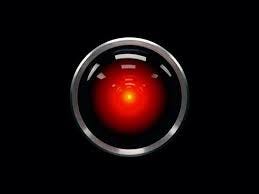Between 1966 and 2009, actor Majel Barrett provided the voice for most of the Federation’s computers in Star Trek, because the vision of the future was that technology would grow more human over time. In Stanley Kubrick’s 2001, actor Douglas Rain plays the computer HAL adding enough humanity to the role that the audience believes an artificial intelligence could go mad. Human artists bringing humanity to machine characters is an old and effective practice. One that The Andy Warhol Diaries limited series on Netflix reverses, with pointless and disturbing results.
With the permission of Warhol’s estate, director Andrew Rossi worked with a company called Resemble AI to create a virtual Warhol that could read from his diaries, which were originally dictated by Andy to his assistant Pat Hackett, who published them two years after the artist’s 1987 death. All of this is revealed in the documentary’s credits, avoiding the controversy over using AI to recreate the voice of celebrity chef Anthony Bourdain in the documentary Roadrunner. The sign-off by The Warhol Foundation is also meant to put the audience at ease.
But it doesn’t work. As the Middlebrow family watched the first episode together last night, Renaissance Son, who had missed the credits, immediately tagged the voiceover as fake. “Sounds like a computer,” he said. It certainly did not sound like the actual and iconic voice of Warhol, which Rossi includes through archival footage.
The primary defense here is that Andy spoke in a machine-like monotone anyway. But to The Middlebrow’s ear, people who think that way are missing some of the notes in Andy’s voice that AI cannot yet capture. It was not a mechanized tone, it was a distinctly detached one. Andy was an observer, one who purposefully removed himself from society so that he could capture it in art. There’s irony and sarcasm that the AI can’t capture either. When Andy did things like telling the press he was “asexual,” he was not declaring himself a robot, he was criticizing the question, from a step or two away.
Andy’s wigs, makeup and clothing were not attempts at artificiality but self-expression. When he says, as he is quoted at the start of episode one, that “I’d like to be a machine, wouldn’t you?” the words drip with irony. Warhol was a humanist and an orthodox catholic one at that, who understands that we might lament the burdens of original sin (free will, desire and personality) but can’t really wish them away.
Another defense is that Warhol mechanized his artistic process. But that does not mean he dehumanized it. He silkscreened, as other artists did at the time, and made bespoke portraits (rightly characterized as religious icons by Rossi) and he worked with human assistants, but this was all to keep the commerce flowing and the money supported a real human community he’d built around the Factory. It supported a magazine, film production and a glorious nightlife for Andy and his superstars.
In episode one, Rossie interviews Rob Lowe, who muses that Warhol would have loved the contemporary scene, where people find fleeting fame online. The Middlebrow is not so sure that Warhol would be impressed by our world of social media and the emerging metaverse, though. Warhol was an innovator. He broke rules. The contemporary online environment is all about rules. This platform is for microblogging. This one allows images but no links. This one allows videos of a certain length. This one will take down your post if somebody claims a copyright violation. This one bans nude pics. This one moderates political writing, that one moderates public health commentary.
Would Warhol, who made films that director John Waters reminds us were often illegal to show in public at the time, be sending his superstars to Facebook, where moderators frequently take down fine art photography if they depict nudity?
Warhol was just 58 when he died. By all rights, he should still be here to tell us what he thinks about contemporary America. The Middlebrow expects he would have a nuanced take, one that can’t be captured by an artificial intelligence. The Netflix documentary is a fine thing, and one we’ll watch to the end, but the AI gimmick was unnecessary and doesn’t serve to represent Warhol’s humanity.
What’s said about it is that Rossi had an easier solution in front of him. There are plenty of actors who can perform as Andy, rich with heart and irony. Many of those actors are unknown. Rossi could have given the 15 minutes to somebody striving, who would have found meaning in the opportunity, instead of to a computer that benefits in no way from its inadequate portrayal. Using the documentary to make a new star would have been truly Warholian. But Rossi missed the opportunity and fell for a technology company pitch. What a missed opportunity.

